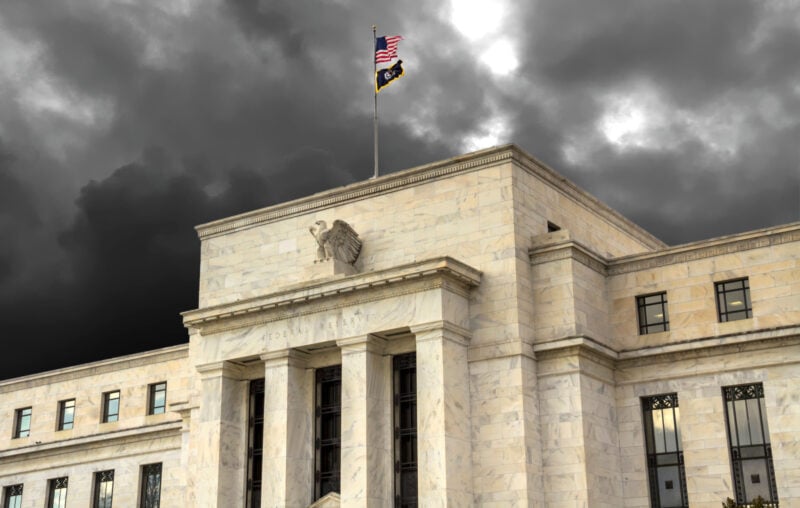Federal Reserve Chair Jerome Powell recently testified before Congress on the current state of the US economy. In addition to monetary policy, Powell was questioned about the Fed’s regulatory proposals regarding cryptocurrencies and climate-related financial risks.
Barely mentioned, however, was the Fed’s balance sheet. The Fed has experienced significant operating losses over the last six months, which have exhausted its existing capital. Those losses represent foregone revenue to the US Treasury.
Operating losses
In the post-pandemic period, the Fed expanded the money supply significantly to support a swift economic recovery. It did so by purchasing vast amounts of US Treasury bonds and mortgage-backed securities. While those assets seemed like good investments at first, they are now a major hole in the Fed’s financial position.
When the bulk of the Fed’s quantitative easing (QE) programs took place in 2020 and 2021, market rates on long-term Treasury bonds fluctuated mostly in the range of 1.5 to 2.0 percent. At the time, the Fed was paying interest on bank reserves and overnight reverse repurchase (ONRRP) agreements of 0.15 or less. The Fed profited on the difference between the higher rate it received from its bond purchases minus the lower rates it paid on reserves and Overnight Reverse Repurchases (ONRRPs).
Now, the Fed has raised the interest it pays to 4.55 percent on ONRRPs and 4.65 percent on bank reserves, but the rates it earns on its QE purchases remain mostly unchanged. Assuming, as a rough approximation, that the bonds it purchased pay an average rate of 1.75 percent, and the average rate paid on bank reserves and ONRRPs is 4.6 percent, then the Fed is paying about 2.85 percent per year more than it receives on its $8 trillion dollar securities portfolio. That’s a loss of $228 billion per year!
The bankrupt central bank
The Fed is bankrupt — and I don’t just mean intellectually.
Like a private bank, the Fed maintains some level of capital as a buffer against losses. When those losses exceed the value of its capital, the Fed becomes insolvent, meaning the liabilities it owes to others are greater than the total value of the assets it holds.
The most recent data show that the Fed owes the Treasury over $41 billion, which exceeds its total capital. The Fed, by common standards, is indeed insolvent.
Deceptively deferred assets
What does the Fed do when its liabilities exceed its assets? It doesn’t go into legal bankruptcy like a private company would. Instead, it creates fictitious accounts on the assets side of its balance sheet, known as “deferred assets,” to offset its increasing liabilities.
Deferred assets represent cash inflows the Fed expects in the future that will offset funds it owes to the Treasury. As the Fed describes, “the deferred asset is the amount of net earnings the Reserve Banks will need to realize before their remittances to the US Treasury resume.” The Fed had already accrued $41 billion in deferred assets, and the amount is only getting larger.
The advantage to deferred assets is that the Fed can continue its normal operations without disruption, although considering the 40-year-high inflation, its recent performance has been less than ideal.
The disadvantage is that, at a time when the Fed is already worsening the US fiscal position by raising interest rates (and therefore interest payments on the federal debt), it is further robbing the Treasury of revenues by deferring them into the future. Those deferred payments, of course, must be shouldered by American taxpayers until the Fed’s remittances resume.
These losses may be offset by any previous gains on the Fed’s QE portfolio, but assessing the net effects of those actions is even more difficult. QE has created massive distortions in the financial system. The Fed’s interest rate tools of interest on bank reserves and ONRRPs have significantly curtailed short-term lending in the banking and financial systems.
A job for Congress?
In addition to its role in managing the money supply, the Fed is the primary regulator of most US banks. If any private bank behaved this irresponsibly, regulators, such as the Fed or Federal Deposit Insurance Corporation (FDIC), would force it to close. Bank managers would lose their jobs and incomes.
Clearly, Congress is not planning to shut down the Fed, and is unlikely to punish it for its poor performance, but there are changes that could be made. The banks that are members of the Federal Reserve System could be forced to cover the capital shortfall, as described in the Federal Reserve Act. The Fed could return to a corridor system of monetary policy, resulting in lower interest paid on bank reserves and ONRRPs relative to market rates and therefore fewer reserves held at the Fed.
Shrinking the Fed’s balance sheet would make another Fed insolvency less likely, while also reducing the Fed’s footprint and the distortions it creates in the financial system. At very least, Fed officials should better manage its operations so as not to be a drain on American taxpayers again in the future.



